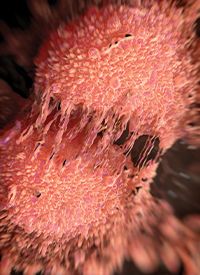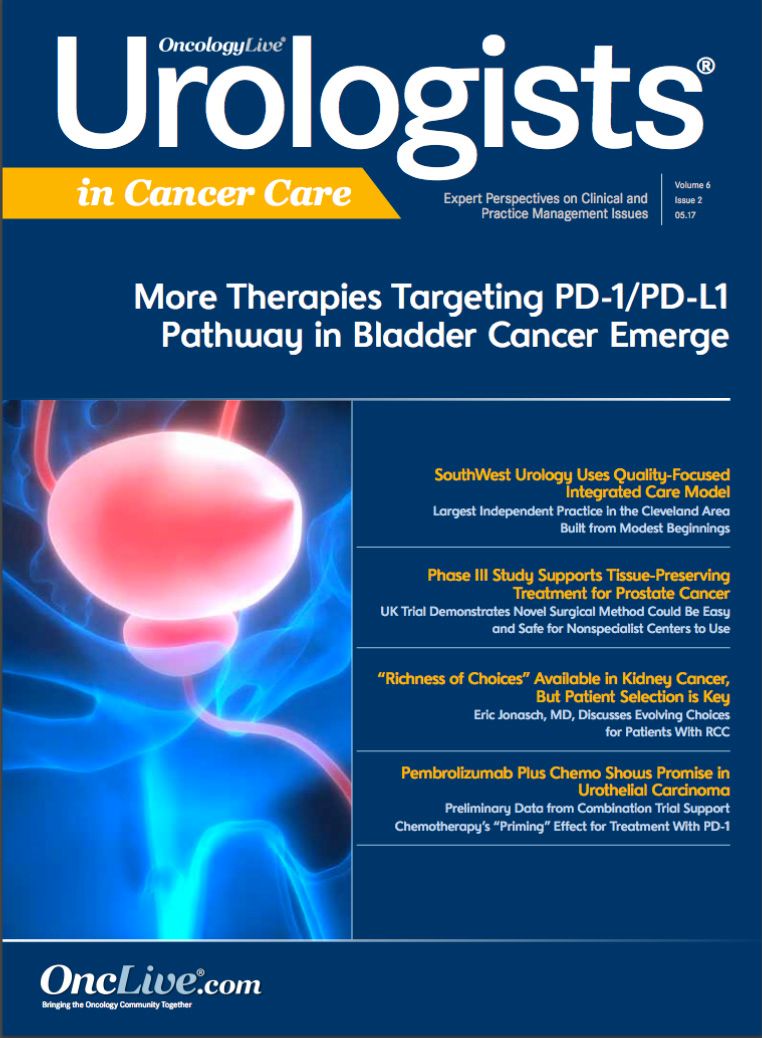Publication
Article
Oncology Live Urologists in Cancer Care®
Docetaxel Combined With Dexamethasone Shows PSA Response in Patients With CRPC
Author(s):
A recent phase II trial demonstrated that the combination of docetaxel-based chemotherapy and dexamethasone showed significantly high PSA responses compared with previous studies in patients with CRPC.

A recent phase II trial demonstrated that the combination of docetaxel-based chemotherapy and dexamethasone showed significantly high prostate-specific antigen (PSA) responses compared with previous studies in patients with castration-resistant prostate cancer (CRPC).1
In the recent single-arm, multi-institutional study, 75 patients with CRPC received 75 mg/m2 of docetaxel and 0.5 mg of dexamethasone orally twice a day throughout the treatment period. The treatment period was planned for 10 cycles, and depending on the observation of PSA test flares, the treatment was continued for at least 4 cycles. The median age was 71 years, and the median PSA level at enrollment was 23.2 ng/mL.1 Eligible patients had histologically confirmed prostate adenocarcinoma, confirmed CRPC, ECOG performance status of 0 to 1, and were receiving either surgical or medical androgen deprivation therapy.
The primary endpoint was PSA response, defined as a reduction from baseline of at least 50% that continued for at least 3 weeks. Secondary endpoints included safety, PSA test flares, time to PSA test failure, and adherence rate to proto- col treatment (10 cycles). Radiographic progression was not evaluated. The investigators focused on PSA response in order to assess the effectiveness of the treatment with statistical significance, and because of the diagnostic significance of PSA testing. It also made it simpler to compare the study results with those of previous trials.
Patients would be eligible for a dose reduction or cessation of dexamethasone if certain adverse events (AEs) were reported, including gastric ulcer, posterior subcapsular cataract, glaucoma, infection, or any other toxicities requiring dose reduction or cessation as judged by the attending physician.1
The results were statistically promising. The PSA response rate was 76.8% (95% CI, 65.1-86.1). Of all evaluable patients, 30 completed the full 10 cycles of chemotherapy (40%). This response rate was significantly higher than the study’s prespecified threshold (30%). Eight patients experienced a PSA test are (10.7%). The median time to PSA failure was 369 days (95% CI, 245-369). The PSA response rate of patients without metastases (16 patients) was 81.3% (95% CI, 54.4- 96.0), and the PSA response rate of patients with metastases (53 patients) was 75.5% (95% CI, 61.7-86.2), showing a notable difference in the parameters of the study.1
The most frequently observed AE was hematotoxicity; neutropenia of grade 1/2 or greater was observed in 100% of patients. Other hematological AEs (all grades) were leukopenia (97.3%), lymphopenia (61.3%), and anemia (97.3%). Other common nonhematological AEs (all grades) included fatigue (70.7%), anorexia (46.7%), peripheral sensory neuropathy (57.3%), peripheral motor neuropathy (24%), and alopecia (69.3%).
The investigators concluded that these results demonstrated a novel PSA response in patients who received docetaxel-based chemotherapy combined with low-dose dexamethasone. Most patients tolerated the protocol schedule, despite the often-seen hematotoxicity.
The study1 raised the question as to whether there was significant benefit in the efficacy and safety of docetaxel-based chemotherapy combined with low-dose dexamethasone in patients with CRPC. Further investigation was needed, and so the Japan-Multinational Trial Organization organized the combination phase II trial to accomplish that.
Previous Research
Further research is still needed. This trial had several limitations, including that radiographic progression was not evaluated. There was also a small sample size, and since the study was single-arm, there is no comparator to confirm the responses. The study also had a short follow-up time period, and so there is no way to assess the PSA response in terms of OS.1 However, the response seen in this trial was excellent, and hopefully more research building on these results will likely be the subject of future trials.One prior study investigating the efficacy and toxicity of low-dose docetaxel combined with dexamethasone found that 65% of evaluable patients had a decrease in their PSA responses >50%.2 The study concluded that low-dose docetaxel in combination with dexamethasone is feasible in patients with CRPC. Grade 3 febrile neutropenia occurred in 2 patients (5%). Nonhematological toxicities were less frequent but sometimes severe. Treatment-related death occurred in 2 elderly patients, due to gastric bleeding in one and to infective endocarditis in the other. Hematological toxicity was less than that seen with standard docetaxel therapy, but it was necessary to monitor patients during the study for severe nonhematological toxicities, particularly in elderly patients.2
A previous study from 2004 (TAX 327) compared treatments of docetaxel plus prednisone versus mitoxantrone plus prednisone for patients with advanced prostate cancer. The study randomized 1006 patients with metastatic hormone-refractory prostate cancer to receive 5 mg of prednisone twice daily, and either 12 mg of mitoxantrone per square meter of body-surface area every 3 weeks, 75 mg of docetaxel per square meter every 3 weeks, or 30 mg of docetaxel per square meter weekly for 5 of every 6 weeks. The primary endpoint was over- all survival (OS).3
The TAX 327 study demonstrated that when given with prednisone, treatment with docetaxel every 3 weeks led to better OS and improved rates of response in terms of pain, PSA levels, and quality of life, as compared with mitoxantrone plus prednisone. The median OS was 16.5 months in the mitoxantrone group, 18.9 months in the group given docetaxel every 3 weeks, and 17.4 months in the group given weekly docetaxel. Among these groups, 32%, 45%, and 48% of patients, respectively, had at least a 50% decrease in their PSA level (P <.001 for both comparisons with mitoxantrone).3
References
- Tanaka N, Nishimura K, Okajima E, et al. The e cacy and safety of docetaxel-based chemotherapy combined with dexamethasone 1 mg daily oral administration: JMTO Pca 10-01 phase II trial. Jpn J Clin Oncol. 2017;47(3):247-251. doi:10.1093/jjco/hyw193.
- Miura N, Tanji N, Yanagihara Y, et al. Low-dose docetaxel combined with dexamethasone is feasible for patients with castration-resistant prostate cancer. Chemotherapy. 2016;61(1):23-31. doi: 10.1159/000440942.
- Tannock IF, de Wit R, Berry WR, et al; TAX 327 Investigators. Docetaxel plus prednisone or mitoxantrone plus prednisone for advanced prostate cancer. N Engl J Med. 2004;351(15):1502-1512.










